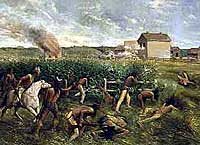Minnesota's Uncivil War
September 26, 2002
By Mark Steil and Tim Post, Minnesota Public Radio

A war fought in the Minnesota River valley back in 1862 still leaves scars today. On one side were the Dakota Indians. On the other, settlers and the U.S. government. Hundreds of people died on both sides of the five-week long war. It lead to the largest mass execution in U.S. history, when 38 Dakota were hanged in Mankato.
Much has been written about the Dakota war, but the impact on descendants is less studied. More than a century later, the war still sparks intense debate. But the events are seen by many in a much different light now.



View images of the conflict

The Dakota Conflict trials, by Douglas Linder, University of Missouri-Kansas City Law School
Surviving the Dakota Conflict, by Wakanhdi Sapa (Black Lightning), Oct. 2000
Books
Kinsmen of Another Kind, by Gary Clayton Anderson
Through Dakota Eyes, edited by Gary Clayton Anderson and Alan Woolworth
Bury My Heart at Wounded Knee, by Dee Brown
The Sioux Uprising of 1862, by Kenneth Carley
A History of Minnesota, by William Folwell
History of the Santee Sioux, by Roy Meyer
Over the Earth I Come, by Duane Schultz


Producers: Mark Steil and Tim Post
Broadcast editor: Kate Smith
Online editor: Melanie Sommer
Art director: Ben Tesch
Production supervisor: Michael Wells
Historical voices: Lindsay Timmington,
Vernon Ashley, Bob Kelleher, Bob Reha, Laurel Druley

|  |

Exiled at Crow Creek
After the conflict, Minnesota's Dakota Indians were expelled from the state. It was one of the most heartbreaking results of the 1862 war. When the Dakota were defeated, the federal government rounded up the survivors. Most were sent to Crow Creek, S.D., where disease and starvation killed many. There's still a reservation there, and times are still hard.
A woman of contradiction
Jane Gray Swisshelm did not follow the stereotypical life of a frontier woman in the 1860s. Swisshelm was a St. Cloud newspaper editor with strong opinions. She used her position to fight against slavery and for women's rights. But while she wrote articles advocating more freedom for some, she also pushed for the complete extermination of the state's Dakota Indian population.
What should we call it?
Over the years the U.S.-Dakota Conflict in southern Minnesota has carried different labels. When white historians first wrote the story in the late 1800s and early 1900s, the fighting was referred to as the Great Sioux Massacre or the Great Sioux War. It later became the Sioux Uprising of 1862. The most popular choice these days in to call it the U.S.-Dakota Conflict of 1862. But some say the term "war" is more accurate than "conflict," and want it changed again.

What's your opinion of relations with Indians today? What should we call the conflict? Share your thoughts in the MPR Forum.
|